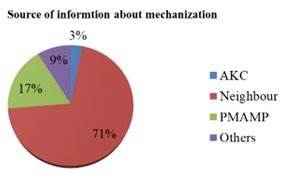Status of farm mechanization and factor affecting its adoption among the rice (Oryzae sativa) farmers in Sarlahi district, Nepal
Abstract
This study aimed to investigate the degree of agricultural mechanization adoption and the factors influencing its acceptance in the Haripurwa municipality and Parsa rural municipality of Sarlahi district, specifically concerning rice agriculture using a multistage random sampling method. A total of 98 respondents were selected for the study, 52 were from Haripurwa municipality and 46 were from Parsa rural municipality. Primary data were collected using semi-structured questionnaires, focal group discussion, and key informant interviews whereas secondary data were obtained through review of relevant literature. The data was analyzed using descriptive statistics, scaling and indexing, chi-square tests, T-tests, and the logit model. By analyzing the adoption index, 62.245% and 37.755% of respondents were under the adopter and non-adopter categories respectively. In contrast to 100% physical labor for transplanting, fertilizer application, and other intercultural tasks like weeding and harvesting, the study found that land preparation was done mechanically (100%). The two biggest obstacles to the use of agricultural machinery were small farms scattered terrain and poor infrastructure with index values of 0.845 and 0.843, respectively. Major factors influencing agricultural mechanization were respondents' educational status, gender, farmers' experience, participation in organizations, loan availability, and primary source of family income. Thus, it can be said that socio-economic determinants which had a significant association with adoption status and most needed farm implements for farmers can be considered by the concerned authority to increase the farm mechanization and enhance profitability from rice farming.
Keywords:
Adoption, Agriculture, Farmer, Mechanization, RiceDownloads
References
Akram, N., Akram, M. W., & Hongshu, W. (2020). Study on the Socioeconomic Factors Affecting Adoption of Agricultural Machinery. Journal of Economics and Sustainable Development, 68–80. https://doi.org/10.7176/jesd/11-3-07
Aryal, J. P., Rahut, D. B., Thapa, G., & Simtowe, F. (2021). Mechanisation of small-scale farms in South Asia: Empirical evidence derived from farm households survey. Technology in Society, 65, 101591. https://doi.org/10.1016/J.TECHSOC.2021.101591
Barman, S., Deka, N., & Deka, P. (2019). Factors Affecting Farm Mechanization – A Case Study in Assam, India. Asian Journal of Agricultural Extension, Economics & Sociology, 1–7. https://doi.org/10.9734/AJAEES/2019/V32I130146
Bhandari, S., Bhandari, S., K.C., S., Badu, R., Dhital, P. R., & Khanal, A. (2023). Assessment of agricultural mechanization status in rice production and its challenges in the western Nepal. Archives of Agriculture and Environmental Science, 8(2), 236–243. https://doi.org/10.26832/24566632.2023.0802021
Bhattarai, P., Gyanwali, P., Pokharel, N. P., Bashyal, P., Mainali, R., & Khanal, R. (2024). Agro-morphological analysis of yield and yield attributing traits of wheat under heat stress condition. Agriculture and Food Sciences Research, 11(1), 30–35. https://doi.org/10.20448/aesr.v11i1.5486
CDD. (2015). Rice varietal mapping in Nepal: Implication for development and adoption. Crop Development Directorate, DoA, Hariharbhawan, Lalitpur.
Dangol, B. B. S. (2004) Extension education. Dangol Printers, Kathmandu, Nepal.
Fahad, S., Adnan, M., Noor, M., Arif, M., Alam, M., Khan, I. A., Ullah, H., Wahid, F., Mian, I. A., Jamal, Y., Basir, A., Hassan, S., Saud, S., Amanullah, Riaz, M., Wu, C., Khan, M. A., & Wang, D. (2019). Major Constraints for Global Rice Production. In Advances in Rice Research for Abiotic Stress Tolerance (pp. 1–22). Elsevier. https://doi.org/10.1016/B978-0-12-814332-2.00001-0
FAOSTAT. (2023). Retrieved March 21, 2023, from https://www.fao.org/faostat/en/#home
Gc, A., Yeo, J., & Ghimire, K. (2019). Turkish Journal of Agriculture - Food Science and Technology Determinants of Farm Mechanization in Nepal. 7(1), 87–91.
Khatiwada, D., Dutta, J. P., Shrestha, K., Adhikari, G., & Paudel, H. (2021). Economic Impact of Agricultural Mechanization in Rice Farming in Shivasatakshi Municipality of Jhapa District, Nepal. Food and Agri Economics Review, 1(1), 41–45. https://doi.org/10.26480/faer.01.2021.41.45
MoALD, 2021. (2021). Statistical Information On Nepalese Agriculture (2077/78 ). Publications of the Nepal in Data Portal, 73, 274.
MOALD. (2022). Statistical Year Book. Singhadurbar, Kathmandu: Government of Nepal.
Paudel, S., Pokharel, N. P., Adhikari, S., & Poudel, S. (2021). Heat and Drought Stress Effect in Wheat Genotypes: a Review. Food and Agri Economics Review, 1(2), 77–79. https://doi.org/10.26480/faer.02.2021.77.79
Pokhrel, A., Dhakal, S., Kafle, R., & Pokhrel, A. (2021). Adoption status of improved production technology in rice cultivation in Kanchanpur, Nepal. Archives of Agriculture and Environmental Science, 6(2), 178–185. https://doi.org/10.26832/24566632.2021.060209
Prasad, R., Shivay, Y. S., & Kumar, D. (2017). Current Status, Challenges, and Opportunities in Rice Production. In B. S. Chauhan, K. Jabran, & G. Mahajan (Eds.), Rice Production Worldwide (pp. 1–32). Springer International Publishing. https://doi.org/10.1007/978-3-319-47516-5_1
Sisay Getaneh. (2021). Drivers to Adoption of Irrigated Fodder Technologies and Its Impact on þÿSmallholder Farmers Income: Evidence from Innovation Lab for Small-Scale Irrigation Project Sites , Ethiopia . Master Thesis. 1–18.
Thapa, G., Kumar, A., & Joshi, P. K. (2019). Agricultural transformation in Nepal: Trends, prospects, and policy options. In Agricultural Transformation in Nepal: Trends, Prospects, and Policy Options (Issue November 2019).
https://doi.org/10.1007/978-981-32-9648-0
Tranmer, M., & Elliot, M. J. (2016). Binary Logistic Regression Mark Tranmer Mark Elliot. April.
Uprety, R. (2010). Meshing mechanization with SRI methods for rice cultivation in Nepal. Paper Presented at Rice for Future Generations the Third International Rice Congress IRC 812 November 2010 in Hanoi Vietnam, 1–5. http://www.ricecongress.com/previous/pdflink/3932.pdf
Verma, M., & Tripathi, A. (2015). Perspective of agricultural mechanization in Supaul district of North Bihar-a Research. Journal of Agriculture and Veterinary Science, 8(8), 4-12.

Published
How to Cite
Issue
Section
Copyright (c) 2024 Agriculture and Environmental Science Academy

This work is licensed under a Creative Commons Attribution-NonCommercial 4.0 International License.

